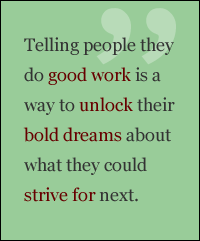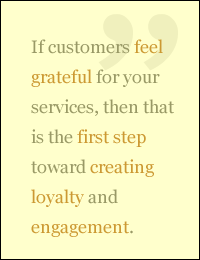Since World War II, much of psychology has focused on a pathology model -- that is, exploring what's wrong with people, not what's right. But recently, a new vision of psychology has emerged -- the positive psychology perspective. Led by such pioneers as Donald O. Clifton, Ph.D., Martin Seligman, Ph.D., and Mihaly Csikszentmihalyi, Ph.D., positive psychology explores ways to help people flourish rather than simply function. This view provides rich possibilities for executives who want to improve company performance by encouraging, promoting, and expanding human potential. Applying positive psychology can have a direct impact on employee and customer engagement and loyalty -- and thus the bottom line.
Barbara Fredrickson, Ph.D., is on the vanguard of the Positive Psychology movement. Fredrickson, a research psychologist at the University of Michigan, specializes in the study of positive emotions and developed the "broaden-and-build" theory. She is also a Senior Scientist for The Gallup Organization -- one of several researchers from around the globe who teach at major Gallup conferences, conduct publishable research, and lend their expertise to Gallup research design and consulting. Her findings shed new light on human behavior and contradict many business truisms, among them the notion that people can "leave work at work and home at home." Dr. Fredrickson's insights also provide startling implications for anyone who wants the best out of a boss, employee, or customer.
 |
GMJ: How is positive psychology defined? And how is it different from more traditional approaches?
Dr. Fredrickson: For the last 50 years or so, clinical psychology has been all about trying to cure mental illnesses, and we've done really well at developing treatments. But psychologists really didn't have the tools from that same solid, scientific, quantitative lens to help people truly flourish and thrive.
So positive psychology is about taking the methods and skills that psychology is really good at and directing them toward helping people move from languishing to flourishing. It has implications for how we treat and inspire people. My own work involves recasting positive emotions as an important means of flourishing and thriving. Positive emotions aren't just the icing on the cake, but something that seems to be essential to get people, organizations, or teams to thrive. And once you recast positive emotions, it can change how you interact with others, how you compliment good work, and how you motivate people.
GMJ: Tell me about your broaden-and-build theory.
Fredrickson: The broaden-and-build theory is about the evolutionary significance of positive emotions. In some ways, it's best viewed in contrast to the way we typically understand negative emotions. The evolutionary significance of negative emotions -- once taken to be the significance of emotions in general -- is that they get people to act in particular ways (in jargon terms: "specific action tendencies"), but they're best known as "fight" or "flight."
But the adaptiveness of positive emotions is not best seen in an instant, like fight or flight responses. Positive emotions are better observed over the long haul. Their effects accumulate and compound over time, and the adaptive benefit is evident later, when people face new challenges.
GMJ: How does this work?
Fredrickson: Positive emotions don't necessarily narrow people toward a specific action, like negative emotions do. Positive emotions seem to broaden people's repertoires of things they like to pursue. They broaden ways of thinking beyond our regular baseline, and they accumulate. And that broadening allows people to discover and learn new things. It fuels self-transformation and allows people to learn new things about themselves or make new connections with other people. And so through broadening, people build their personal resources: friendships, styles of connecting with people, knowledge of their own abilities, or even physical health and strength. They build a wide range of different resources that, in the long run, end up functioning as reserves that help people cope and survive.
GMJ: How can positive psychology or the broaden-and-build theory help managers increase the engagement levels of employees?
Fredrickson: One place to start would be finding ways to connect people that would generate more positive emotions in your workgroup. Allow people to connect with others on a human level at work, so that when they're coming to work, they're coming to a place they want to be, somewhere they feel recognized. And really look at the emotions they're expressing, and use that as your proximal indicator.
When we are given permission to focus on emotions, a new dimension of the human landscape just pops out. If you pay attention to and track emotions, especially positive emotions, I think that you capture a lot more information that will help you make decisions.
GMJ: So, for example, my manager tells me I'm swell. What are my positive emotions, and how do they affect my job?
Fredrickson: Small things have to accumulate and compound to have an effect. Something may seem trivial at the moment, but you have to realize that when these things stack up and are aggregated, they become crucial.
 |
When someone recognizes your good work, you might feel proud. Pride makes people start dreaming about achieving something similar but bigger. Pride is the fuel for achievement motivation. So telling people they do good work is a way to unlock their bold dreams about what they could strive for next. And when people are inspired to dream big, they're basically charting their next level of goals.
GMJ: How do positive emotions like pride relate to Gallup's research on employee engagement?
Fredrickson: In my estimation, many of the items on the Q 12 [Gallup's 12-item survey that measures employee engagement; see "Feedback for Real" in See Also] are indirect indicators of positive emotions. Having a best friend at work or receiving recognition every week makes you feel cared for or proud, respectively. If you want to keep recreating those positive emotions, then you keep coming back to work.
So the Q 12 measures engagement, and engagement is a positive emotional connection to work. You can use the mechanisms of the broaden-and-build theory and the action tendencies of positive emotions to explain why the Q 12 has been so powerful for Gallup in terms of predicting outcomes.
GMJ: If you're getting an awful lot of negative emotions at work or at home, can you compartmentalize them? Are they going to carry over?
Fredrickson: I would think they'd carry over, because people carry their brains with them wherever they go. Emotions perpetuate themselves. Positive emotions beget positive emotions, but bitterness begets bitterness.
GMJ: Do you see a connection between your work and what Gallup is doing with customer engagement?
Fredrickson: Well, my work could apply to customer engagement in some of the same ways that it applies to employee engagement -- creating a positive emotional connection. If people feel grateful for your services, then that is the first step toward creating loyalty and engagement. In fact, I've done a lot of reading about gratitude. Theorists talk about how one way of repaying gratitude is with loyalty. And if you can harness that and find ways to make people feel grateful for what you've done for them, they're more likely to repay you with loyalty.
GMJ: Gallup has found that customer satisfaction doesn't translate into higher sales, but emotional bonding does.
Fredrickson: Well, if you're looking at things from the lens of emotions, it's obvious that would be the case, because customer satisfaction is a judgment, whereas emotional bonding is a feeling. It's an emotional moment that people are remembering, and it's easily represented in a snapshot memory.
GMJ: How do you teach people to create a positive psychology in customers?
Fredrickson: When people feel like they're being recognized as a human being on the other side of a transaction, as opposed to being the transaction, then they have a more positive response. But that's the hard part about using this in a business sense, because sometimes people wonder, is that guy for real?
GMJ: That just happened to me. A waiter "recognized me as a human" to such an extent that I thought he was unhinged.
Fredrickson: Well, that's where sincerity really comes in, because if your customers think you're not being genuine, then it's a problem.
GMJ: What other kinds of positive emotions apply to customer engagement?
Fredrickson: All kinds: fun, interest, contentment, or serenity. Generally, people try to recreate experiences that make them feel good. Positive emotions act as their own reward. This is the magic ingredient of positive emotions -- why they're so useful. Positive emotions have all these beneficial outcomes, but people don't have to think about them -- they just have to think, "That felt good, and I'd like to repeat it." It's evolution's clever design -- by repeating positive emotions, people are accruing resources. And so if you work with the idea that people want to recreate the thing that made them have a good experience in the first place, you should keep people returning.
GMJ: In other words, prices or ads don't make people engaged customers -- it's a human connection. If people feel that a company has connected with them on a personal level, they're more likely to be engaged with that company, and they'll go out of their way to purchase there or pay more than they would somewhere else.
Fredrickson: Yes. So go out of your way to connect with people on a human level. Provide a service that's valuable, one that makes people think that the fit is so right that it's almost a gift. People are grateful for gifts. Someone, a benefactor, has done something above and beyond the call of duty -- whether or not they really did. So make it your duty to go above and beyond the call of duty. And when people sense that one organization is doing that more often than others, that's what will create loyalty and engagement.
-- Interviewed by Jennifer Robison